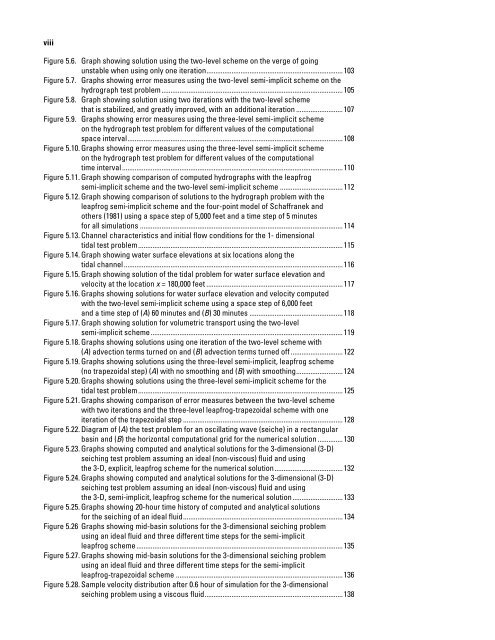A Semi-Implicit, Three-Dimensional Model for Estuarine ... - USGS
A Semi-Implicit, Three-Dimensional Model for Estuarine ... - USGS
A Semi-Implicit, Three-Dimensional Model for Estuarine ... - USGS
Create successful ePaper yourself
Turn your PDF publications into a flip-book with our unique Google optimized e-Paper software.
viii<br />
Figure 5.6. Graph showing solution using the two-level scheme on the verge of going<br />
unstable when using only one iteration............................................................................103<br />
Figure 5.7. Graphs showing error measures using the two-level semi-implicit scheme on the<br />
hydrograph test problem.....................................................................................................105<br />
Figure 5.8. Graph showing solution using two iterations with the two-level scheme<br />
that is stabilized, and greatly improved, with an additional iteration ..........................107<br />
Figure 5.9. Graphs showing error measures using the three-level semi-implicit scheme<br />
on the hydrograph test problem <strong>for</strong> different values of the computational<br />
space interval........................................................................................................................108<br />
Figure 5.10. Graphs showing error measures using the three-level semi-implicit scheme<br />
on the hydrograph test problem <strong>for</strong> different values of the computational<br />
time interval ...........................................................................................................................110<br />
Figure 5.11. Graph showing comparison of computed hydrographs with the leapfrog<br />
semi-implicit scheme and the two-level semi-implicit scheme ...................................112<br />
Figure 5.12. Graph showing comparison of solutions to the hydrograph problem with the<br />
leapfrog semi-implicit scheme and the four-point model of Schaffranek and<br />
others (1981) using a space step of 5,000 feet and a time step of 5 minutes<br />
<strong>for</strong> all simulations .................................................................................................................114<br />
Figure 5.13. Channel characteristics and initial flow conditions <strong>for</strong> the 1- dimensional<br />
tidal test problem..................................................................................................................115<br />
Figure 5.14. Graph showing water surface elevations at six locations along the<br />
tidal channel..........................................................................................................................116<br />
Figure 5.15. Graph showing solution of the tidal problem <strong>for</strong> water surface elevation and<br />
velocity at the location x = 180,000 feet ............................................................................117<br />
Figure 5.16. Graphs showing solutions <strong>for</strong> water surface elevation and velocity computed<br />
with the two-level semi-implicit scheme using a space step of 6,000 feet<br />
and a time step of (A) 60 minutes and (B) 30 minutes ....................................................118<br />
Figure 5.17. Graph showing solution <strong>for</strong> volumetric transport using the two-level<br />
semi-implicit scheme...........................................................................................................119<br />
Figure 5.18. Graphs showing solutions using one iteration of the two-level scheme with<br />
(A) advection terms turned on and (B) advection terms turned off .............................122<br />
Figure 5.19. Graphs showing solutions using the three-level semi-implicit, leapfrog scheme<br />
(no trapezoidal step) (A) with no smoothing and (B) with smoothing..........................124<br />
Figure 5.20. Graphs showing solutions using the three-level semi-implicit scheme <strong>for</strong> the<br />
tidal test problem..................................................................................................................125<br />
Figure 5.21. Graphs showing comparison of error measures between the two-level scheme<br />
with two iterations and the three-level leapfrog-trapezoidal scheme with one<br />
iteration of the trapezoidal step .........................................................................................128<br />
Figure 5.22. Diagram of (A) the test problem <strong>for</strong> an oscillating wave (seiche) in a rectangular<br />
basin and (B) the horizontal computational grid <strong>for</strong> the numerical solution ..............130<br />
Figure 5.23. Graphs showing computed and analytical solutions <strong>for</strong> the 3-dimensional (3-D)<br />
seiching test problem assuming an ideal (non-viscous) fluid and using<br />
the 3-D, explicit, leapfrog scheme <strong>for</strong> the numerical solution......................................132<br />
Figure 5.24. Graphs showing computed and analytical solutions <strong>for</strong> the 3-dimensional (3-D)<br />
seiching test problem assuming an ideal (non-viscous) fluid and using<br />
the 3-D, semi-implicit, leapfrog scheme <strong>for</strong> the numerical solution............................133<br />
Figure 5.25. Graphs showing 20-hour time history of computed and analytical solutions<br />
<strong>for</strong> the seiching of an ideal fluid.........................................................................................134<br />
Figure 5.26 Graphs showing mid-basin solutions <strong>for</strong> the 3-dimensional seiching problem<br />
using an ideal fluid and three different time steps <strong>for</strong> the semi-implicit<br />
leapfrog scheme...................................................................................................................135<br />
Figure 5.27. Graphs showing mid-basin solutions <strong>for</strong> the 3-dimensional seiching problem<br />
using an ideal fluid and three different time steps <strong>for</strong> the semi-implicit<br />
leapfrog-trapezoidal scheme .............................................................................................136<br />
Figure 5.28. Sample velocity distribution after 0.6 hour of simulation <strong>for</strong> the 3-dimensional<br />
seiching problem using a viscous fluid.............................................................................138

















